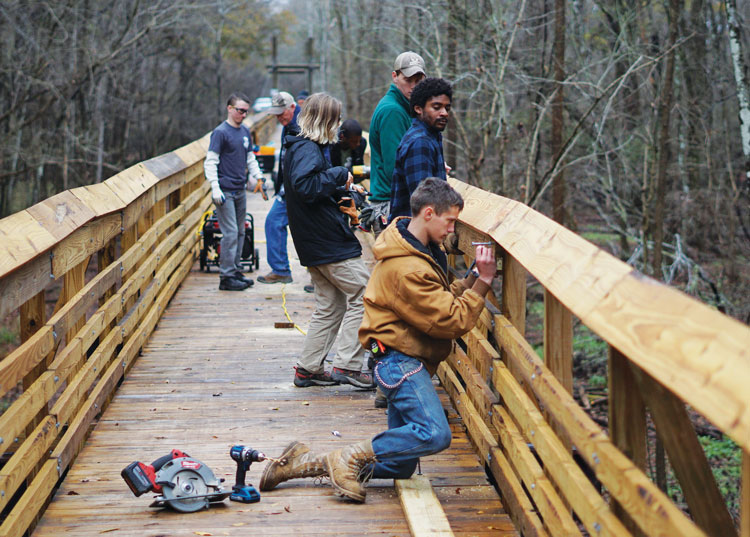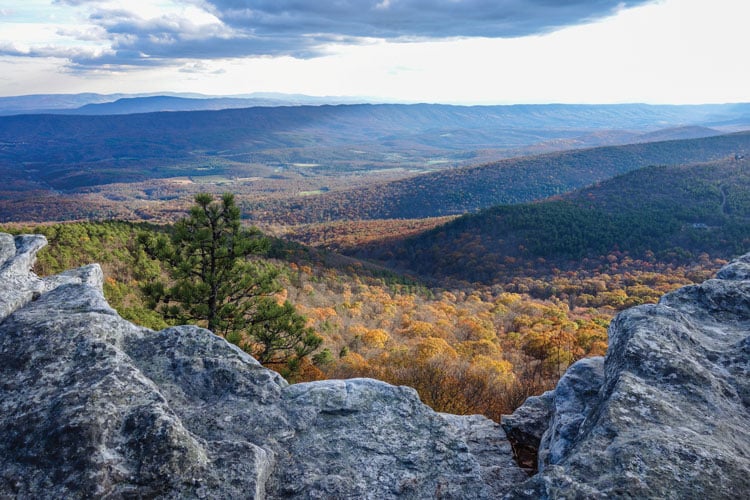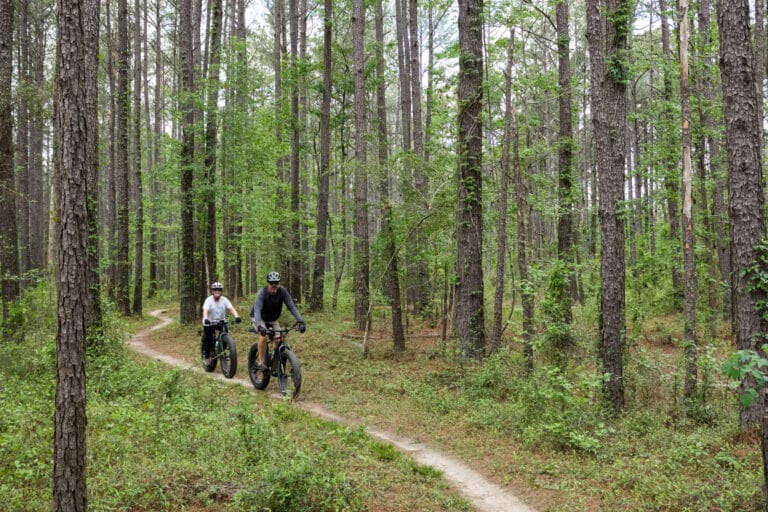Looking for a different kind of thru-hike? Try one of these less-crowded long-distance trails
Since Earl Shaffer claimed the first Appalachian Trail thru-hike in the 1940s, hikers from around the world have set out on the 2,200-mile trail in search of something.
The power and solitude of the trail has been well documented in popular books, films, and now social media.
But as the number of people attempting to thru hike continues to grow, the Appalachian Trail Conservancy is trying to promote more sustainable use to preserve the National Scenic Trail for generations to come.
Laurie Potteiger, the information services manager for the Appalachian Trail Conservancy, said the number of thru hikers has been steadily increasing since the 70s, especially in recent years as the trail and resources have become more accessible.
“Some days, more than 100 people were starting,” Potteiger said. “Close to 4,000 people started in 2017. The way that you impact the trail has a really big variation depending on how you conduct yourself and when you go. There’s a lot we can do to educate people about making choices that help preserve the trail and give them the best experience.”
Although an A.T. thru hike does not require a permit, attempting hikers can now register their trip on the conservancy’s website. This allows hikers to see when the busiest days are and plan accordingly.
The ATC has also started promoting the idea of a flip flop thru hike instead of the traditional point to point, northbound, or southbound route.
“It benefits the trail to spread out hikers, but it can also benefit the hiker,” Potteiger said. “It may not be for everyone. We’re just offering a different way to experience the trail that might be more appealing to you. The terrain is more gentle toward the middle of the trail. You can start later, miss the cold, snow, and ice, as well as the crowds. So, you can eliminate those negative factors.”
The idea is catching on. In 2017, there were more flip floppers than southbound thru hikers for the first time. The impact flip floppers have spreads beyond the trail.

Alternate A.T. Thru Hike
As a trail maintainer for the Potomac Appalachian Trail Club, Deb “Mona Lisa” Coleman had seen firsthand the effects of increased use on the A.T.
When she started doing research for her 2017 thru-hike, she envisioned starting at the southern terminus in Georgia and making her way north to Maine like the majority of thru-hikers. That is, until she came across the concept of a flip flop hike on the ATC’s website.
“I knew about the impact on the trail that the bubble from northbound hikers have,” Coleman said. “It just made sense when I read about the crowds and lessening my impact on the trail.”
With a flip flop, there are almost infinite routes as thru hikers can start anywhere on the trail. After making it to the southern or northern terminus, they return to the starting point and head in the opposite direction.
“I think I came to a full shelter only one time, which is pretty amazing,” Coleman said. “North bounders have a really hard time not just finding space in the shelters but even finding campsites. I think that’s a big part of the impact of the bubble is that there are more people that are camping so they’re camping in pristine areas.”
The most common flip flop, and the one Coleman took, starts in Harpers Ferry, W. Va. northbound. After climbing Mount Katahdin in Maine, she traveled back to Harpers Ferry and made her way south to Springer Mountain, Georgia.
Coleman said this route made sense for her because she couldn’t start until May, it made it easier to build her trail legs, and gave her a psychological advantage because she didn’t see as many hikers leaving the trail.
“I started in a relatively easy part of the trail where the terrain did not have as many elevation changes,” she said. “It got increasingly more difficult so by the time I got to the hardest part of the trail, which was New Hampshire and Maine, I felt like I was really ready. The trail had prepared me. But I hadn’t been on the trail for so long that I was feeling depleted.”
The advantages of a flip flop extend beyond the hiker and the trail.
“The flip floppers help to support the trail side communities and businesses,” Coleman said. “When we come through, it’s their off season so we help them to extend their season. That’s good for the trail and good for hikers in general.”
Whether you’re looking for a shorter thru hike or a less crowded one, explore one of these long-distance trails, in various stages of completion, for a new experience.
Tuscarora Trail
Va., W. Va., Md., and Penn.
Over the course of two years, Pete Taylor and his hiking partner hiked all 252 miles of the Tuscarora Trail. Designed as an alternative route on the A.T. when developers struggled to get the right of way through Virginia and Maryland, the Tuscarora challenges hikers of all abilities.
“The Tuscarora follows a very rocky ridge,” Taylor said. “It is not a fun hike from that standpoint. Once you get into Pennsylvania, or Rocksylvania as we like to refer to it, it is very, very rugged. You’ll go for miles on nothing but rock scrambles. It’s a spectacular hike with all of the vistas, but it’s a very difficult hike.”
Thru hikers also have to contend with how to resupply as the trail communities are not built up like they are along the A.T.
“A lot of people will go up ahead of time and drop off food,” Taylor said. “But there are a lot of opportunities if you’ve got someone who is willing to resupply you because you spend a lot of time hiking on roads.”
The Tuscarora offer hikers a quieter trail before meeting up with the A.T. at both the southern and northern terminus.
“The Tuscarora Trail is what the Appalachian Trail was 30 years ago,” Taylor said.
Cumberland Trail
Tenn.
More than 50 years after plans for the Cumberland Trail were first proposed, the 300-mile project is on its way to linking the public lands in Eastern Tennessee along the Cumberland Plateau.
Day hikers can choose from several trails varying in length and difficulty while thru hikers should be prepared for strenuous elevation change and rocky terrain in the more remote areas.
“It offers the ability to get away in solitude,” said Rob Weber. “There are certain trailheads that are pretty busy on the weekend, but if you’re going to hike the Cumberland Trail, you’re really going to get into some of the last wilderness in the Cumberland Plateau. It’s areas that we’ve been working for the last couple decades to put under conservation protection.”
Weber, chair of the Cumberland Trail Conference, said that with 93 percent of the land acquired, the focus is now on constructing the remaining 90 miles of trail.
“With so much of the trail acquired, we’re in this critical point where we’re putting all of our energy towards building,” Weber said. “We have more corridor than we know how to get built. That’s a good sign of a victory.”
The conference has a paid crew working on the trail, funded through private donations, grants, and any creative methods they can think of, in addition to volunteers. They also host college students every year through the Alternative Spring Break program.
Pinhoti National Recreation Trail
Ala. and Ga.
When Michelle Markel finished her thru hike of the Pacific Crest Trail, she started looking for the longest hikes around the country. At 337 miles, the Pinhoti is the longest trail in Alabama and Georgia, running through the Talladega and Chattahoochee National Forests.
“The Pinhoti is a really great trail to go out and thru hike to see if you really like it,” Markel said. “A lot of people will go out and spend $1,000 on gear, quit their jobs, give their boss the middle finger. Then they get out and three days later, they’re like I don’t really like this. So, the Pinhoti is a fantastic sort of test drive.”
While most of the route is on trails through public lands, there are a few sections in Georgia that require some serious road walking.
At the northern terminus, Markel connected with the Benton MacKaye Trail to link up with the Appalachian Trail for a longer hike.
“The Pinhoti includes the southernmost Appalachian Mountain over 1,000 feet,” she said. “So, by starting on the Pinhoti, you can actually walk the entire Appalachian chain if you connect to the A.T.”
Benton MacKaye Trail
Ga., Tenn., and N.C.
Named for the original designer of the Appalachian Trail, the Benton MacKaye Trail takes hikers through challenging backcountry. The terrain on the 300-mile trail is similar to the A.T. with strenuous climbs and descents.
“MacKaye’s route was a little different than the way the Appalachian Trail ended up,” said Barry Allen. “Our route actually follows his vision a little closer. We crisscross a couple of times, form a figure eight. In general, we run a much more westerly and remote route than the Appalachian Trail. In some areas, you’ll be lucky to run into one or two people on the route during the entire day you’re hiking.”
Allen, president of the Benton MacKaye Trail Association, coordinates the work that goes in to keeping this trail accessible to the public.
“With any trail association, the public needs to understand that we are maintained almost entirely by volunteer work,” Allen said. “So, if you’re a hiker and you’re not giving back by doing volunteer work, then we certainly need people to reconsider that. Spend some time helping us maintain the trails.”

Foothills Trail
S.C., N.C.
Although only 77 miles, the Foothills Trail winds through some of the best the Carolinas have to offer, connecting Table Rock State Park and Oconee State Park. This trail takes hikers to countless waterfalls, including Whitewater Falls and Laurel Fork Falls, as well as over Sassafras Mountain, the highest point in South Carolina.
The Foothills Trail Conservancy, which coordinates volunteers and maintenance on the trail, offers a shuttle service for thru hikers looking to get from one state park to the other.
Heyward Douglass, executive director of the conservancy, said they get visitors from all over the world who say this is one of the best maintained trails they have ever been on.
“Bridges, waterfalls, vistas, the whole nine yards,” Douglass said. “You’ve kind of taken the Appalachian Trail and shrunk it down into 77 miles.”
Mountains-to-Sea Trail
N.C.
As the name implies, the Mountains-to-Sea Trail in North Carolina stretches 1,175 miles from Clingmans Dome to the Outer Banks.
This cross-state trail runs through mountain towns, agricultural centers, and oceanfront public lands. Several sections allow bikes and horses while optional routes give paddlers a taste of the state’s waterways.
Kate Dixon, executive director of Friends of the Mountains-to-Sea Trail, said the number of thru hikers is already increasing, even though the full trail is not complete.
“We had maybe 10 people between 1997 and 2008 who finished,” she said. “Right now, we’re having 16 or 17 people complete in a year. My guess is those numbers are going to keep rising. We reached a tipping point where there is enough trail and camping has gotten easier.”
Towns like Hillsborough and Elkin have embraced their status as a trail community as volunteers and land management agencies work to put the remaining 500 miles on trails.
“We have a couple of communities that have really shown what this trail can mean if a community really gets behind it,” Dixon said. “Town boards see it as a valuable quality of life issue for their citizens, but also there’s an interest in it for economic impacts, just having hikers come through.”
Palmetto Trail
S.C.
Before tackling a thru hike of the A.T., Bernie and April Hester wanted to do some hiking locally to prepare. That’s when they learned about the 500-mile Palmetto Trail that runs across South Carolina.
“We had never done any kind of long-distance hiking, we were figuring our way out,” Bernie Hester said. “The trail runs through national forests, small towns, big cities. The first time we did it, we kept coming across people who asked, ‘Why are you doing this?’ We didn’t know, it just seemed interesting.”
The second time they thru hiked, the couple set out with a more concrete goal, raising money and awareness for the Multiple Sclerosis Society in support of April Hester, who was diagnosed with MS when she was 20.
Broken up into passageways of varying difficulties, the goal of the Palmetto Trail is to improve quality of life through conservation and human powered recreation. The Hesters have taken full advantage of the trail, having attempted three thru hikes on a trail that most users do in sections.
The annual Palmetto Challenge encourages teams of hikers and bikers to log as many miles on the state’s trails in an 8-week period. Furry friends count as team members.
Great Eastern Trail
Ala. to N.Y.
To the west of the A.T., a group of dedicated trail clubs are slowly closing the gap on another long-distance trail along the East Coast. At around 1,800 miles, the Great Eastern Trail is made up of a series of existing trails that are being linked together, including parts of the Pinhoti, Cumberland, and Tuscarora Trails.
Tom Johnson, president of the Great Eastern Trail Association, estimates that 75 percent of the route is now on a trail. Much like the A.T., a majority of the work is being done by volunteers coordinated through 11 trail clubs from Alabama to New York.
“Everything is very decentralized, and all the individual clubs are responsible for their own geographic area,” Johnson said. “If there is a connection issue, they’re responsible for working with the trail club immediately north or south to close the gap.”
Within the last few years, a huge effort has gone into closing the trails between the Finger Lakes in New York and Pennsylvania, as well as connecting the trail through Tennessee.
In areas where road walking is needed to connect parts of the trail, volunteers are working to acquire the land needed to get the whole route off road.
“Southwestern West Virginia and far eastern Kentucky down to Breaks Interstate Park is really the hole in the donut,” Johnson said. “The area that we go through is the coal mining area. All those lands that are not in the towns are pretty much owned by coal companies.”
Completion of the project will depend on public support through donations, trail construction, and local government.







